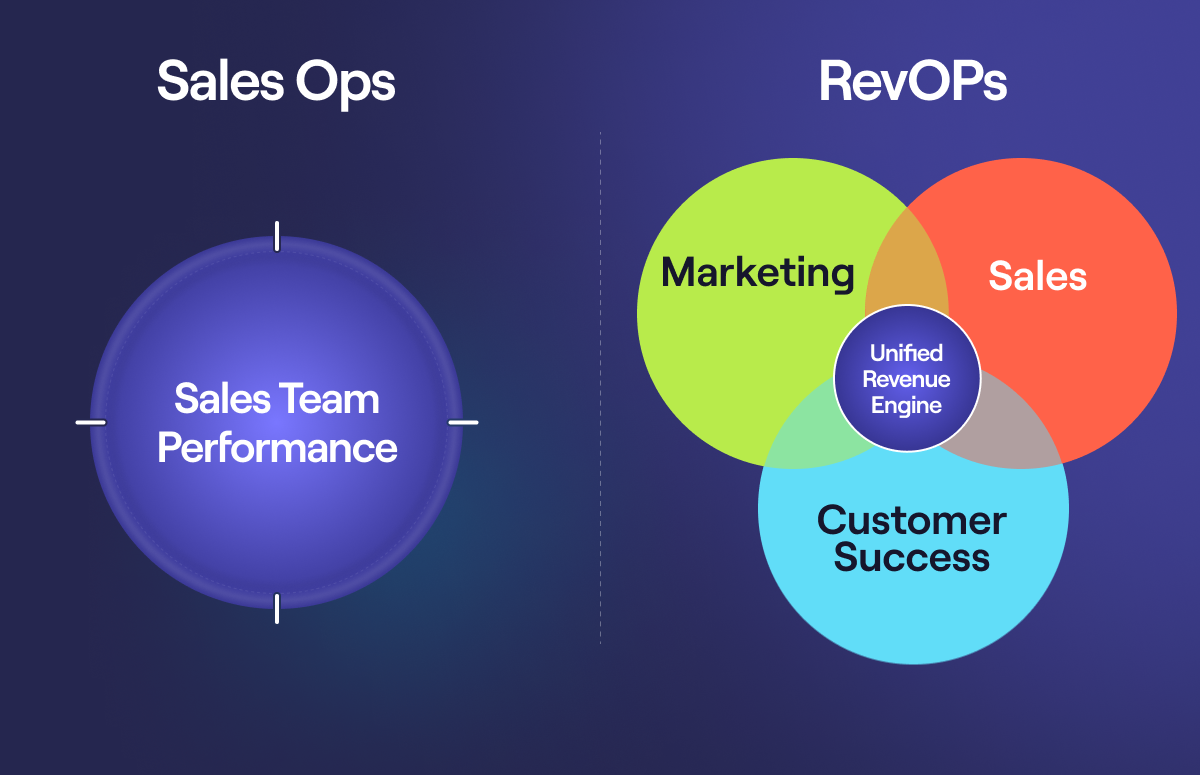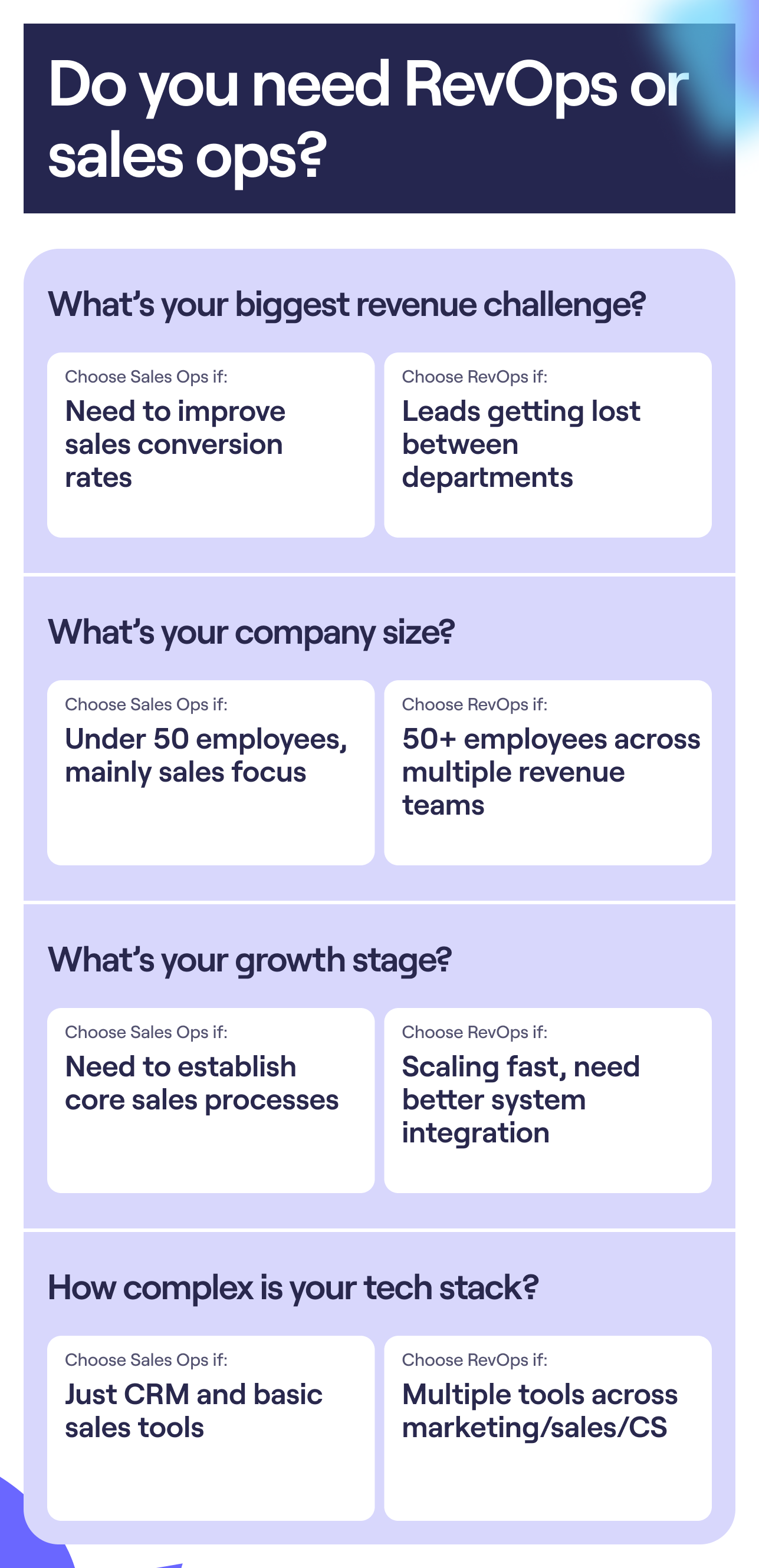RevOps vs. Sales Ops: What’s the Difference?
RevOps vs. Sales Ops menu:
RevOps vs. sales ops - what’s best for your company?
This guide helps you make an informed decision. Read on to:
- Understand what each function does.
- Know the key differences in roles and responsibilities.
- Identify which one your B2B company needs right now.
- Avoid common setup mistakes.
Let’s make this choice simple 👇
Revenue operations vs. sales operations: Key differences at a glance
What is RevOps?
Revenue operations (known as RevOps) takes a holistic approach to revenue generation. Instead of focusing on individual departments, RevOps aligns your entire revenue engine - marketing, sales, and customer success - under one operational framework.
In doing so, RevOps addresses a critical problem: revenue leakage.
Think of it this way: modern B2B buying isn’t linear. Your customers don’t experience your company in departmental silos - they move between marketing, sales, and customer success, often simultaneously.
This is when revenue starts slipping through the cracks - leads get lost between marketing and sales, expansion opportunities get missed, and customer data is trapped in departmental silos.
A RevOps team plugs these revenue leaks by:
- Creating a single source of truth for customer data.
- Building consistent processes across departments.
- Managing technology decisions across teams.
- Developing unified reporting and analytics.
- Ensuring smooth customer handoffs between teams.
- Creating accurate forecasting across the revenue cycle.
- Measuring and optimising the entire customer journey.
Gartner predicts that by 2026, 75% of the highest-growth companies will adopt a RevOps function, up from less than 30% today.
The downside? RevOps requires significant organisational maturity to be effective.
What is sales ops?
Think of sales ops as your sales team’s engine room. It’s the function that eliminates the chaos stopping your sales reps from doing what they do best - selling.
Your sales representatives are probably wasting hours on admin tasks right now. They’re manually updating CRMs, wrestling with reporting tools, and figuring out which leads to prioritise. That’s exactly what sales ops fixes.
A sales ops team turns your sales floor from chaotic to clockwork by:
- Building and maintaining your sales tech stack.
- Creating repeatable sales processes.
- Managing and cleaning your sales data.
- Setting up territory planning.
- Handling sales forecasting.
- Running sales analytics and reporting.
- Managing sales commission structures.
However, you’ll find as your business grows, sales ops is fundamentally limited. While it can brilliantly optimise your sales function, it wasn’t built to handle the full revenue journey, from marketing to customer success.
This is where the conversation about RevOps usually begins.
What are the major differences between RevOps and sales ops?
Let’s break down the essential differences between RevOps and sales ops.
Spoiler alter: The distinctions run much deeper than just about adding marketing and customer success to the mix.
1. Scope and focus
Sales ops zeros in on one mission: maximising sales team performance. They’re the special forces unit dedicated to making your sales machine run better, faster, and smoother.
RevOps, however, takes a bigger-picture approach. It orchestrates the entire revenue journey, ensuring marketing, sales, and customer success work as one unified revenue engine.

2. Decision making
Here’s a practical example of how this plays out:
When sales ops evaluates a new sales tool, they’re primarily focused on:
- Will this help our sales team close more deals?
- Can this integrate with our existing sales stack?
- What’s the ROI for the sales department?
When RevOps evaluates the same tool, they’re asking:
- How will this affect our entire revenue process?
- Can marketing use this data for better targeting?
- Will this help customer success spot expansion opportunities?
- Does this create a better overall customer experience?
3. Data management
Sales ops creates a single source of truth for sales data. RevOps creates a single source of truth for all revenue data.
This difference is crucial. In a sales ops model, you might have:
- Marketing data living in marketing automation tools.
- Sales data in your CRM.
- Customer success data in your support platform.
RevOps breaks down these silos, creating a unified view of your customer across their entire journey with your company.
4. Process optimisation
Sales ops optimises processes within the sales function, such as lead routing, territory planning, and sales forecasting.
They’re brilliant at it, but their influence stops at the boundaries of the sales team.
RevOps takes a cross-functional approach to process optimisation. They look at:
- How marketing-qualified leads become sales-qualified leads.
- How closed deals transition to customer success.
- How customer feedback flows back to product development.
- How expansion opportunities move back into the sales pipeline.
5. Performance metrics
The metrics that matter to each function tell you everything about their different focus areas.
Sales ops typically tracks:
- Sales cycle length.
- Conversion rates.
- Pipeline velocity.
- Sales productivity metrics.
- Individual rep performance.
RevOps monitors all these plus:
- Customer acquisition cost (CAC).
- Customer lifetime value (CLV).
- Net revenue retention.
- Cross-functional conversion rates.
- End-to-end customer journey metrics.
6. Team structure and reporting
Sales ops typically reports to the Head of Sales or Chief Sales Officer. The team structure focuses on supporting sales leadership and frontline sales professionals.
RevOps often reports directly to the CEO or Chief Revenue Officer, reflecting their broader mandate. The team structure usually includes specialists focused on:
- Marketing operations.
- Sales operations.
- Customer success operations.
- Revenue analytics.
- Revenue systems and tools.
When do you need RevOps vs. sales ops?
Here’s your cheat sheet to help you make the right choice:

When’s the perfect time for RevOps?
RevOps becomes crucial when your customer journey starts spanning multiple teams. The signs are usually pretty clear:
- Marketing blames sales for not following up on leads.
- Sales blames marketing for poor lead quality.
- Customer success feels left in the dark about new customers.
- Everyone’s running their own tech stack.
- Your revenue forecasting feels like three different stories.
This typically happens as companies scale beyond $10M ARR and have established marketing, sales, and customer success teams. By this point, your tech stack will have grown to include marketing automation, CRM systems, and customer success platforms.
When’s the perfect time for sales ops?
Your sales team is your main focus right now. Maybe you’re hiring reps like crazy, or your sales process needs a serious cleanup. Sound familiar?
You’ll know you need sales ops when:
- Your reps are drowning in admin instead of selling.
- Your CRM data looks like a mess.
- New reps take ages to get up to speed.
- Your sales forecasting feels like guesswork.
- Your team keeps reinventing the sales process.
This usually happens when companies are in their early growth stages, focusing primarily on building and optimising their sales function. Your tech stack is probably sales-focused, too - mainly CRM and sales engagement tools.
Set your ops team up for success
Whether you choose RevOps or sales ops, success comes from:
- Maintaining a ruthless focus on the customer experience.
- Building scalable, documented processes.
- Investing in clean, accessible data (Cognism can help!).
- Measuring what matters for your current stage of business growth.
A word to the wise:
The most successful companies don’t just implement these functions - they empower them.
Give your ops team the authority, resources, and strategic input they need to drive real change. Your revenue growth depends on it.
Frequently asked questions
What is the core difference between RevOps and sales ops?
The main difference between RevOps and sales ops is scope. Sales ops focuses on optimising sales team performance through tools, data, and processes. RevOps aligns sales, marketing, and customer success to streamline the revenue process, enhance collaboration, and drive overall revenue growth.
Can I have both RevOps and sales ops teams?
Yes - larger enterprises often run both.
Sales ops handles day-to-day sales optimisation while RevOps manages cross-functional strategy and alignment.
In companies with both functions, sales ops often reports to RevOps to ensure alignment.
Do I need RevOps if I already have sales ops?
Not necessarily.
If your sales team is your main focus and you’re not experiencing issues with cross-department alignment, a well-running sales ops function is better than premature RevOps implementation.
The right time usually comes when your company needs to scale efficiently across marketing, sales, and customer success.
Is my company too small for RevOps?
Size isn’t always the deciding factor.
While RevOps is typically introduced at $10M+ ARR, some companies need it earlier if they experience significant alignment issues between revenue teams.


.png)